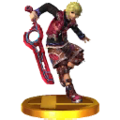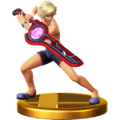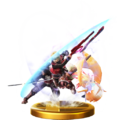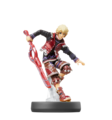Shulk (SSB4)
| Shulk in Super Smash Bros. 4 | |
|---|---|
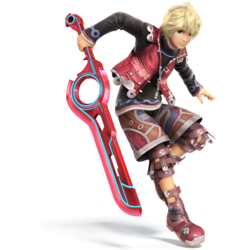 
| |
| Universe | Xenoblade Chronicles |
| Availability | Starter |
| Final Smash | Chain Attack |
| Tier | G (44) |
| “ | Shulk Foresees a Fight! | ” |
| —Introduction Tagline | ||
Shulk (シュルク, Shulk) is a playable character in Super Smash Bros. 4. Initially leaked alongside Bowser Jr. and Ganondorf via footage used by the ESRB, Shulk was officially confirmed on August 29th, 2014, the same day that Xenoblade Chronicles 3D, the New Nintendo 3DS port of his Wii debut title Xenoblade Chronicles, was announced. Additionally, he was the final character revealed prior to the release of Super Smash Bros. for Nintendo 3DS. Adam Howden and Shintarō Asanuma reprise their roles as Shulk's voice actors in the English and Japanese versions of SSB4, respectively.
Shulk is currently ranked 44th out of 58 on the SSB4 tier list, placing him at the top of the G tier. Thanks to the Monado, he possesses the longest overall disjointed range of any character in the entire series. This gives Shulk one of the most effective movesets for spacing relative to the rest of the cast, which is most evident with his wide-ranged neutral and forward aerials, as well as long-ranged smash attacks that have consistent KO potential.
Shulk also boasts wide versatility thanks to his Monado Arts, which allow him to adapt his attributes to fit the situation while opening up opportunities that he would not have without them. This includes outstanding recovery with Jump, one of the best approach speeds with Speed, very high survivability with Shield, a very high overall damage output with Buster, and some of the strongest finishing moves in the game with Smash. In addition to their general benefits, Jump grants potent edgeguarding and aerial combo potentials, while Speed and Buster grant grounded combo potential. He also has one of the most effective counterattacks in Vision, which has the longest counter window of any counterattack when fresh while also boasting high range and power.
However, Shulk is hindered by very sluggish frame data: almost none of his attacks start before frame 9, and his aerial attacks cannot autocancel whatsoever. This makes him highly prone to punishment and out of shield retaliation, and when combined with his tall stature, makes it difficult for him to avoid juggling.
Shulk also has a very high learning curve, as his Arts give him new weaknesses, different mobility speeds and/or different knockback angles to consider. His Arts are also involved with his most advanced techniques, such as Monado Art Landing Lag Canceling (MALLC) or B-reversing Monado Arts, both of which are highly difficult to perform consistently. These issues make Shulk difficult and/or unwieldy to use consistently in high-level play compared to other characters.
Despite his learning curve, a few dedicated mains constantly work to find set-ups and technical combos that are unique to Shulk due to his Monado Arts, with their efforts resulting in him achieving some degree of tournament success.
Attributes
Much like in his home game, Shulk is a fighter who revolves around adapting to different situations with his attribute-enhancing Monado Arts. In comparison to the extreme changes granted by his Arts, most of Shulk's characteristics are relatively balanced: his walking, dashing, falling speeds and gravity are all average, while his air acceleration is slow and his air speed is above average. Shulk is also a heavyweight, being the third heaviest swordsman in the game behind Ike and Link. Thanks to his aforementioned stats, Shulk has relatively good mobility for a character of his weight class, especially in the air, although he does not possess too many real advantages or disadvantages in regard to his default attributes.
Shulk's greatest strength is his unmatched disjointed reach. The Monado's range grants him the single longest disjointed melee attacks in the series (even surpassing those of Cloud and Ike), with most of his normal attacks having overall large swings or long-reaching stabs. Shulk's extreme range allows him to punish careless moves by retaliating at a distance, or create space by challenging his opponent with his wide attacks. His most notable grounded moves include his neutral attack, up tilt and smash attacks, each of which possess impressive traits. His neutral attack is the most damaging non-infinite neutral attack in the game even without Buster, his up tilt boasts outstanding vertical range and can cover multiple get-up options from the edge, and his smash attacks all possess high power and long range that can easily reach distant opponents, with his forward smash in particular being the third longest-ranged forward smash in the game behind Corrin's and Mii Gunner's.
His range also applies to his aerial moves, which benefit even more and grant him a powerful air game. Both his neutral and forward aerials possess wide-arced swings with low landing lag, making them Shulk's best approach options. The former is useful for anything from starting combos to covering landing options due to its long-lasting hitbox and low landing lag, while the latter lasts shorter and has slightly more landing lag, but ends faster making it a very good edgeguarding and spacing tool. His other aerials consist of narrow stabs, with his back aerial boasting great reach and the most power of his aerials, granting him a powerful finishing move. Up and down aerials are both difficult to connect due to their minimal horizontal reach, but can KO surprisingly early should they hit, with the former being potent near the upper blast line and the latter possessing the ability to meteor smash.
Excluding his Arts, Shulk's special moveset shares his overall high range, and all have their own forms of utility. Back Slash is very powerful if striking the opponent's back and has long range regardless, making it a great surprise attack as well as a spacing tool. Air Slash grants a good amount of vertical distance, comes out quickly, and has decent knockback, making it a good recovery and an even better out of shield option. Finally, Vision is tied with Double Team for having the longest lasting counterattack window in the game when fresh while having the longest range as well, giving him one of the most effective counters of any character. Its secondary counterattack, which is performed when Shulk inputs the direction from which the triggered attack came from, also rivals Corrin's Counter Surge as the strongest counterattack in the game.
Shulk's defining abilities are his aforementioned Monado Arts. Each Art tweaks his attributes considerably for 16 seconds and can be manually canceled at any time, even during hitstun. With this freedom, Shulk can activate an Art to open up options for virtually any situation while still being able to switch or cancel them if he is in a bad position. Jump grants him significant aerial mobility by making his jumps the highest in the game while improving both his air speed and Air Slash's height. This allows him to recover from almost anywhere off-stage, edgeguard more aggressively and even perform several KO combos, such as a wall of pain leading to a sacrificial Air Slash at moderate percentages or a buffer-canceled up throw to up aerial at high percentages. Speed amplifies his usually average ground speed while reducing his jump height, making his short hopped aerials more efficient for combos and spacing, while allowing him to approach and retreat noncommittally. It also lowers traction, making Shulk's pivot grab one of the longest-ranged in the game for its duration. These two Arts grant him outstanding mobility for a heavyweight, and when combined with the large hitboxes of his attacks, Shulk can effectively space opponents out of a specific side of the stage with either Jump or Speed, making him very difficult to approach on stages with platforms.
Shield bolsters his defensive game, reducing both damage and knockback taken, granting Shulk high survivability while also being able to resist getting trapped in combos. His shield also becomes more durable, making it harder to break with shield-breaking attacks such as Bowser Bomb. Buster reduces knockback but increases his damage output, allowing him to rack up damage extremely quickly. Both up and down throws becoming potent combo starters at 0%, and the increased damage and shieldstun makes Shulk's moves safer on shield while also letting him deal more shield damage, which lets him break shields with moves such as a fully connected down smash. Finally, Smash boosts his entire moveset's knockback, making almost all of Shulk's attacks KOing options (especially with rage), and his down throw becomes the strongest in the game while it is in effect. With access to these attribute-changing abilities, Shulk is highly adaptational and usually has an easier time mixing up his playstyle compared to other characters, so long as his Arts are used effectively and in tandem with his powerful air game.
Due to his Monado Arts, Shulk also has access to an advanced technique unique to him named Monado Art Landing Lag Canceling. By jumping and timing the activation of an Art just before landing, Shulk can reduce the landing lag of his aerials to 5 frames while gaining intangibility for 14 frames (1 frame less than the length granted by his sidestep). While difficult to perform, it allows Shulk to avoid a punish before immediately responding with a punish of his own, or start shield break combos such as an Art canceled back aerial to forward smash. It can even let him retreat by pivoting in midair. This technique is the only viable way to make some of Shulk's moves (such as back aerial) safe on shield against faster characters, and if mastered, can be a very effective and unpredictable mix-up option inaccessible to any other fighter in the game.
However, Shulk has some glaring and exploitable weaknesses. Despite having outstanding range, his moveset is infamously sluggish to compensate, being among the slowest in the game along with King Dedede and Ganondorf. Barring his neutral attack, standing grab and Vision, none of his attacks start before frame 9, while none of them have less than 25 frames of ending lag (barring down tilt). Like the aforementioned heavyweights, this means he has to rely on careful reads to land a hit, as a missed attack can easily be capitalized upon by his opponent. This is made worse by the low shieldstun of his attacks (unless Buster is active), making his attacks inherently unsafe up close (and especially on shield), while still unsafe if spaced against faster characters prevalent in the metagame. Additionally, most of Shulk's moves deal more damage with the Monado's blade rather than its beam blade, while several of his strongest combos (such as a landing neutral aerial to a grab or a forward aerial wall of pain) rely on him being extremely close to his opponent to be inescapable. As a result, Shulk is somewhat reliant on being at a punishable distance to start dealing any significant damage.
His sluggish moves also extends to his aerials. While he is uniquely the only character who can interrupt the ending lag of his aerials with a jump, air dodge or another air attack, all of Shulk's aerials have disproportionately high ending lag (neutral air in particular having 71 frames of ending lag). In addition, Shulk is the only fighter who cannot autocancel any of his aerials, forcing him to endure landing lag every time he starts an aerial attack even from a full hop. While Monado Art Landing Lag Canceling can negate this, it is considerably more complicated to perform compared to autocanceling, making it very difficult and unwieldy to perform consistently. Essentially, this makes it important for Shulk to space his attacks carefully as he can easily be punished for missing, while moves such as back aerial or up aerial are unsafe to use upon landing, unlike many other characters' aerials.
His attributes as a heavyweight, while granting him good survivability, also makes him a very easy target for combos and juggling, as his tall frame and low air acceleration makes it difficult for him to escape from them. Additionally, his fastest aerial (neutral aerial) comes out on frame 13 and begins behind himself, making it difficult to break out of combos at point blank range. His lack of a projectile and lack of anti-projectile options also makes it difficult to pressure his opponent from a distance, while making it hard for him to approach against projectile users as well. Even pressure on the ground can be hard to escape from, as Shulk has the fifth lowest traction in the game. This gives him a poor out of shield game without Air Slash, which is punishable when missed.
Shulk's special attacks are also flawed in some ways. Back Slash's knockback is exceptionally weak if hitting the opponent's front, has considerable ending lag, and notoriously does not edge sweetspot. Air Slash provides very little horizontal momentum and does not sweetspot ledges immediately if the second slash is used, thus making his recovery predictable, even with Jump. Vision's counter window decays upon consecutive use, discouraging the move's frequent use.
Finally, Shulk's signature Monado Arts also have drawbacks to compensate for his stat buffs; if an Art is active, it causes some of his other stats to drop, weakening some of his abilities. A careful opponent can potentially take advantage of them to gain the upper hand, making his Arts a double-edged sword as he is reliant on them to approach or perform combos. Jump makes him very vulnerable to damage, and when combined with his slow moveset, makes it even riskier to whiff a move. Speed lowers his damage output, requiring him to deal more hits for the same amount of damage and reduces his jump force to the point of hindering his vertical mobility. Shield drastically reduces his mobility and damage output to the point of making his recovery and offensive potential among the worst in the game, respectively. Shield's increased knockback defense also leaves Shulk heavily susceptible to combos and juggling that can be difficult to escape from due to his decreased mobility. Buster increases his vulnerability to damage (although not to the same extent as Jump) and the lower knockback makes it nearly impossible to KO opponents without smash attacks, even well over 150%. Finally, Smash severely reduces his survivability, hinders his combo game, and his attacks become the least damaging in the game.
Even having no Arts active is disadvantageous, as his balanced attributes do not allow him to easily approach or catch up with opponents. Having no Arts active also hinders Shulk offensively: very few of his moves possess combo potential past low percentages, and all his smash attacks have high ending lag, making them very punishable. This forces Shulk to be reliant on edgeguarding and spacing while waiting for an Art to refresh, and requires him to capitalize on the duration of a needed Art to the fullest in order to perform certain techniques (such as combo strings or approaching), compared to other fighters who may have the ability to do so at any time.
Shulk's custom moves grant him various options. Decisive Monado Arts last longer and have amplified effects, but cannot be changed. This makes them great for regaining neutral or claiming stage control, but at the cost of their dynamic flexibility in the middle of the match. Hyper Monado Arts last much shorter and with even harsher debuffs, but their buffs are even more powerful, which allows him to briefly boost a needed stat to the extreme and capitalize upon its benefits in a much shorter time. Back Slash Leap offers quicker start-up and more vertical range, at the cost of some horizontal range and more ending lag. Advancing Air Slash gives more horizontal distance and the second hit is stronger, but it gives less vertical distance. Mighty Air Slash is more powerful, but has only half the range, making it difficult to connect the second hit. Dash Vision is weaker than normal, but it has much more range, is much faster upon activation, and gives Shulk both his only anti-projectile option and another recovery option. Lastly, Power Vision has much more start-up upon counterattacking and a much stricter counter window if used repeatedly, but the counterattack itself is immensely powerful and capable of generating one-hit KOs, especially with Smash.
Overall, Shulk works much like his counterpart in Xenoblade Chronicles who plays optimally by keeping pressure off him and having extensive knowledge of his enemy; his weaknesses are exploitable if fighting head-on, but his adaptability and array of wildcard-like tools lets him excel if played patiently while exploiting openings. However, due to his uncommonly sluggish attacks and techniques that require nearly frame perfect technical skill, he is arguably one of the hardest fighters to master. While he has a notable playerbase who constantly discover and improve on his unique Art-Canceling mechanic, his weaknesses give him low representation and only some degree of competitive success despite his potential, with most of his representation coming from dedicated mains such as Nicko and Darkwolf.
Update history
Shulk has been heavily buffed, both directly and indirectly, via game updates and is considered to be among the most directly buffed characters along with Marth and Lucina. Update 1.0.4 increased the damage outputs on all of his attacks, while the changes to shield mechanics brought about by updates 1.1.0 and 1.1.1 make his attacks harder to punish on shield and have also turned several of his attacks into surprisingly effective shield breakers, especially when used in conjunction with Buster.
In addition, all of Shulk's tilt attacks and aerial attacks received slight increases to their damage outputs in update 1.1.3, along with all of his aerials having their landing lag decreased. Other than these buffs, his attacks have only been given minor tweaks and hitbox adjustments during updates. As a result of these buffs, Shulk is considered to be much more viable than how he was during the initial release of SSB4.
 Neutral attack deals more damage: 3% → 3.5% (hit 1, hit 2), 4.3%/3.2% → 5.3%/4.2% (clean hit 3/late hit 3).
Neutral attack deals more damage: 3% → 3.5% (hit 1, hit 2), 4.3%/3.2% → 5.3%/4.2% (clean hit 3/late hit 3). All tilt attacks deal 1% more damage: 12%/10.5% → 13%/11.5% (forward), 7%/6% → 8%/7% (up), 8%/6% → 9%/7% (down).
All tilt attacks deal 1% more damage: 12%/10.5% → 13%/11.5% (forward), 7%/6% → 8%/7% (up), 8%/6% → 9%/7% (down). Forward tilt's knockback growth decreased: 100 → 92, slightly hindering its KO ability despite its increased damage.
Forward tilt's knockback growth decreased: 100 → 92, slightly hindering its KO ability despite its increased damage. Down tilt's second hitbox's position has changed: bone 25, offset [0,2,-1] → bone 0, offset [0,5.5,5.5]. This removes the move's point blank blind spot.
Down tilt's second hitbox's position has changed: bone 25, offset [0,2,-1] → bone 0, offset [0,5.5,5.5]. This removes the move's point blank blind spot. Dash attack deals 1% more damage: 10% → 11%.
Dash attack deals 1% more damage: 10% → 11%. Dash attack's ending lag decreased: frame 57 → 53.
Dash attack's ending lag decreased: frame 57 → 53. Forward and up smash deal more damage: 5%, 12.5%/11% → 5.5%, 13%/11.5% (forward), 4%, 13% → 4.5%, 13.5% (up).
Forward and up smash deal more damage: 5%, 12.5%/11% → 5.5%, 13%/11.5% (forward), 4%, 13% → 4.5%, 13.5% (up). Forward smash has been improved. It received a variety of changes to enable both of its hits to connect together better.
Forward smash has been improved. It received a variety of changes to enable both of its hits to connect together better. Forward smash's first hit's angles altered: 40° (upward)/75° (forward)/84° (downward) → 78°/10°/40°.
Forward smash's first hit's angles altered: 40° (upward)/75° (forward)/84° (downward) → 78°/10°/40°. Forward smash's first hit's fixed knockback values decreased: 45/45/31 → 28/28/28.
Forward smash's first hit's fixed knockback values decreased: 45/45/31 → 28/28/28. Forward smash's first hit's radii decreased: 4/4/4 → 2/2/4.
Forward smash's first hit's radii decreased: 4/4/4 → 2/2/4. Forward smash's first hit's positions elevated: [-2,0,1]/[4.1,0,1]/[10,0,1] → [11–4,0,2]/[11–4,0,-0.5]/[-2,0,1].
Forward smash's first hit's positions elevated: [-2,0,1]/[4.1,0,1]/[10,0,1] → [11–4,0,2]/[11–4,0,-0.5]/[-2,0,1]. Forward smash's second hit's radii increased: 3.5/2 → 4/3.
Forward smash's second hit's radii increased: 3.5/2 → 4/3. Forward smash's second hit's first hitbox X-offset decreased: 22–0 → 21–0.
Forward smash's second hit's first hitbox X-offset decreased: 22–0 → 21–0. Down smash deals 1% more damage: 13%/10%, 11%/9%, 9%/7%, 7%/5%, 5%/3% → 14%/11%, 12%/10%, 10%/8%, 8%/6%, 6%/4%.
Down smash deals 1% more damage: 13%/10%, 11%/9%, 9%/7%, 7%/5%, 5%/3% → 14%/11%, 12%/10%, 10%/8%, 8%/6%, 6%/4%. All aerial attacks deal more damage: 6%/7% → 7%/8% (neutral), 6.5%/5% → 7.5%/6% (forward), 11%/7% → 12%/8% (back), 4%, 9%/6.5% → 5%, 10%/7.5% (up), 6%/4%, 10%/9% → 7%/5%, 11%/10% (down).
All aerial attacks deal more damage: 6%/7% → 7%/8% (neutral), 6.5%/5% → 7.5%/6% (forward), 11%/7% → 12%/8% (back), 4%, 9%/6.5% → 5%, 10%/7.5% (up), 6%/4%, 10%/9% → 7%/5%, 11%/10% (down). Forward aerial's landing lag decreased: 21 → 18 frames.
Forward aerial's landing lag decreased: 21 → 18 frames. All throws' first hits deal 1% more damage: 2% → 3%.
All throws' first hits deal 1% more damage: 2% → 3%. Monado Speed's damage output multiplier increased for all variations: 0.72x (default, Decisive)/0.576x (Hyper) → 0.8x/0.64x.
Monado Speed's damage output multiplier increased for all variations: 0.72x (default, Decisive)/0.576x (Hyper) → 0.8x/0.64x. Monado Buster's damage input multiplier decreased for all variations: 1.2x (default, Decisive)/1.44x (Hyper) → 1.13x/1.356x.
Monado Buster's damage input multiplier decreased for all variations: 1.2x (default, Decisive)/1.44x (Hyper) → 1.13x/1.356x. All variations of Air Slash deal 1% more damage on the first hit: 5%/4% → 6%/5% (Air Slash, Advancing Air Slash), 8%/6% → 9%/7% (Mighty Air Slash).
All variations of Air Slash deal 1% more damage on the first hit: 5%/4% → 6%/5% (Air Slash, Advancing Air Slash), 8%/6% → 9%/7% (Mighty Air Slash). All variations of Vision have had their Y-offsets increased: 8 → 9.
All variations of Vision have had their Y-offsets increased: 8 → 9.
 Back Slash's start-up lag decreased: 31 frames → 22.
Back Slash's start-up lag decreased: 31 frames → 22. Aerial Back Slash travels slower, making predictions harder.
Aerial Back Slash travels slower, making predictions harder. Up aerial's first hit now launches opponents at 96° and its second hit's hitbox sizes increased: 3.5u/5.5u → 3.8u/6.5u. These changes make its hits connect together better.
Up aerial's first hit now launches opponents at 96° and its second hit's hitbox sizes increased: 3.5u/5.5u → 3.8u/6.5u. These changes make its hits connect together better.
 Dash Vision's knockback growth increased: 84 (standard)/94 (alternate) → 89
Dash Vision's knockback growth increased: 84 (standard)/94 (alternate) → 89 Dash Vision's angle altered: 35° → 32°.
Dash Vision's angle altered: 35° → 32°.
 Dash attack deals 0.5% more damage: 11% → 11.5%.
Dash attack deals 0.5% more damage: 11% → 11.5%. All tilt attacks deal 0.5% more damage: 13%/11.5% → 13.5%/12% (forward), 8%/7% → 8.5%/7.5% (up), 9%/7% → 9.5%/7.5% (down).
All tilt attacks deal 0.5% more damage: 13%/11.5% → 13.5%/12% (forward), 8%/7% → 8.5%/7.5% (up), 9%/7% → 9.5%/7.5% (down). All aerial attacks deal more damage: 7%/8% → 7.5%/8.5% (neutral), 7.5%/6% → 8%/6.5% (forward), 12%/8% → 12.5%/8.5% (back), 5%, 10%/7.5% → 5.5%, 10.5%/8% (up), 5%/7%, 11%/10% → 6%/7.5%, 11.5%/10.5% (down).
All aerial attacks deal more damage: 7%/8% → 7.5%/8.5% (neutral), 7.5%/6% → 8%/6.5% (forward), 12%/8% → 12.5%/8.5% (back), 5%, 10%/7.5% → 5.5%, 10.5%/8% (up), 5%/7%, 11%/10% → 6%/7.5%, 11.5%/10.5% (down). All aerials' landing lag decreased: 12 frames → 10 (neutral), 18 frames → 16 (forward), 21 frames → 19 (back), 17 frames → 15 (up), 25 frames → 23 (down).
All aerials' landing lag decreased: 12 frames → 10 (neutral), 18 frames → 16 (forward), 21 frames → 19 (back), 17 frames → 15 (up), 25 frames → 23 (down).
Moveset
- The Monado deals more damage and knockback on some attacks if it hits from the center of the blade rather than from the tip. In addition, damage outputs and knockback properties can be further manipulated by Monado Arts. The following moveset list details the properties of Shulk's attacks when he has no active Monado Arts.
| Name | Damage | Description | ||
|---|---|---|---|---|
| Neutral attack | 3.5% | A jab, followed by a mid-level roundhouse kick, followed by an upward slash. It is Shulk's fastest move, due to hitting on frame 5, and has good range similarly to Ike's neutral attack. It also boasts the highest damage output of any non-infinite neutral attack in the game, as long as Shield or Smash are not active. | ||
| 3.5% | ||||
| 5.3% (clean), 4.2% (late) | ||||
| Forward tilt | 13.5% (blade), 12% (beam) | An inward slice. It has noticeable ending lag, but is capable of KOing at high percents, especially while Smash is active. It is also capable of hitting opponents close to Shulk's back if pivoted, which can be used as a surprise attack. | ||
| Up tilt | 8.5% (blade), 7.5% (beam) | An overhead, arcing swipe with a very wide radius. A very good anti-air option due to it high vertical range, but lacks a hitbox on both sides of Shulk, leaving him open on the ground. A reliable damage racking option while Buster is active, especially after an up throw, and a good surprise KOing option while Smash is active. | ||
| Down tilt | 9.5% (blade), 7.5% (beam) | A crouching, inward swipe at the opponent's feet. Has the lowest ending lag out of all his moves, and has good range. A good combo starter with Jump, Speed or Buster active, as it launches opponents into the air and in front of Shulk. | ||
| Dash attack | 11.5% | An inward slice. One of Shulk's most potent KOing options while Smash is active. It has very high ending lag, however, and can be punishable if used excessively. | ||
| Forward smash | 5.5% (hit 1), 13% (hit 2 blade), 11.5% (hit 2 beam) | Stabs the Monado forward, causing it to reveal its beam blade while Shulk recoils back slightly. The move has two hits: the first is from the Monado's blade itself, and the second is from its beam blade. Angling upward increases the move's knockback growth, while angling downward allows the move to hit characters hanging from an edge. The third longest reaching non-projectile forward smash in the game, behind Corrin's and Mii Gunner's. An extremely damaging move while Buster is active and a very strong KOing option while Smash is active. However, it has very high ending lag, which makes it extremely punishable if missed or without Buster's higher shieldstun. | ||
| Up smash | 4.5% (hit 1), 13.5% (hit 2) | Kneels down and slams the bottom of the Monado's hilt onto the ground, causing its beam blade to stab upwards. Like his forward smash, there are two hits to this move, with the first hit from the Monado itself leading into its beam blade. Its deceptive horizontal range allows it to punish rolls and landings, while its high vertical range, knockback and transcendent priority makes it a great anti-air move in general. It has noticeable ending lag, though it is slightly lower compared to his forward smash. | ||
| Down smash | 14% (hit 1 blade), 11% (hit 1 beam), 12% (hit 2 blade), 10% (hit 2 beam), 10% (hit 3 blade), 8% (hit 3 beam), 8% (hit 4 blade), 6% (hit 4 beam), 6% (hit 5 blade), 4% (hit 5 beam) | Drags the active Monado in a circle around himself thrice before coming to a stop. The move is capable of hitting during any of its five hitboxes (three at Shulk's front and two at his back), with the first hit having high power for a down smash, and each hit gains range but loses power. While it is possible for this attack to connect more than once, it is difficult to do so unless Shulk is in Buster and his opponent is at a low percentage. This also allows him to break full shields if Buster is active and a shielding opponent is cornered at an edge, as all five hits is enough to completely deplete a shield. Extremely useful for punishing rolls and sidesteps due to its range, but it has the largest amount of ending lag out of all of his smash attacks. | ||
| Neutral aerial | 7.5% (blade), 8.5% (beam) | A circular, upward arcing slash. It is Shulk's most useful approach option due to its wide range (its hitbox begins slightly behind Shulk's toes and continues all the way over his head), low landing lag (10 frames) and high amount of active frames. A great combo starter while Jump, Speed or Buster are active, and can punish air dodges with its length. However, its long-lasting hitbox and high ending lag makes it a very unsafe move to use off-stage when fast falling, as Shulk will be in serious danger of self-destructing. | ||
| Forward aerial | 8% (blade), 6.5% (beam) | An overhead, forward slash in a diagonal arc. It has the least ending lag out of all his aerials, and extreme range for an aerial due to reaching and ending a bit behind him. Great for spacing and interrupting approaches, a powerful combo move with either Speed or Buster active, and a potent edgeguarding move with Jump active, which can allow Shulk to perform a wall of pain. However, it has noticeable landing lag (16 frames), making it punishable on shield at close range or against faster fighters like Little Mac. | ||
| Back aerial | 12.5% (clean), 8.5% (late) | A briefly delayed, reverse gripped thrust behind himself. Its hitbox begins at Shulk's body. Has slow start-up and high landing lag (19 frames), but boasts long horizontal range and high knockback, making it benefit the most from Monado Art Landing Lag Canceling. Shulk's most reliable off-stage KOing and edgeguarding option, especially while Smash is active. | ||
| Up aerial | 5.5% (hit 1), 10.5% (hit 2 blade), 8% (hit 2 beam) | An upward thrust, similar to Link's and Toon Link's up aerials. Functions like his forward and up smashes, with a first hit from the Monado's blade that leads into a second stronger hit from the it beam blade. With the Jump Art active, a landing up aerial can chain straight into another up aerial, leading to a KO. A useful juggling tool against falling opponents and a very strong KOing option when boosted by Smash, courtesy of its deceptively far vertical range capable of reaching through the main platform of Town and City. However, it has minimal horizontal range, which can make it difficult to land. | ||
| Down aerial | 7.5% (hit 1 grounded), 6% (hit 1 aerial), 11.5% (hit 2 blade), 10.5% (hit 2 beam) | A downward thrust, similar to Link's and Toon Link's down aerials. Functions like his forward and up smashes, with a first hit from the Monado's blade that leads into a second stronger hit from the it beam blade. The second hit meteor smashes when sweetspotted. A decent edgeguarding option that can also stage spike edge-hanging opponents, giving Shulk an option to surprise them. However, it has high landing lag (23 frames), making it punishable if missed. Like his up aerial, it has minimal horizontal range. | ||
| Grab | — | Reaches out. Shulk's grab has average range, but while Speed is active, his pivot grab improves due to his reduced traction and improved speed. | ||
| Pummel | 3% | Strikes the opponent's head with the Monado's hilt. A slow pummel, but while Buster is active, it is tied with Olimar's White Pikmin-based pummel as the most damaging pummel in the game. Conversely, it is the least damaging pummel game while either Shield or Smash is active. | ||
| Forward throw | 3% (hit 1), 8% (throw) | An upward swipe. With Speed or Buster active, this can lead into a dash attack or a forward aerial. Although the slash can hit other opponents close by, it deals set knockback on anyone aside from the thrown opponent. | ||
| Back throw | 3% (hit 1), 9% (throw) | A reverse gripped thrust. With Smash active, this is one of the strongest back throws in the game, making it a viable KOing option near the edge. One of the few moves that deals back-facing knockback, which can be followed up with Back Slash while Buster is active. | ||
| Up throw | 3% (hit 1), 4% (throw) | Heaves the opponent in the air and performs a kneeling upward thrust. A reliable combo throw at low percents or with Buster active, as it can lead into several up tilts or Air Slash with Buster active, or a ground attack if the opponent air dodges. At high percents, it can become a set-up into an up aerial while Jump is active, which has the potential to KO opponents if their reaction is read properly. If buffered with the momentum of a canceled Jump, this combo is only escapable with an air dodge, and can work at a wide range of percentages. This is referred to as the Monado Purge Combo. | ||
| Down throw | 3% (hit 1), 4% (throw) | Pins the opponent to the ground and performs a kneeling downward thrust. With Buster active, this may lead into dash attack, forward tilt, forward smash or forward aerial beginning at 0%, with a down throw to forward smash being capable of dealing 35% in two moves. With Smash active, it is the strongest down throw in the game, and consequently Shulk's most powerful throw, which makes it a viable KOing option near the edge. | ||
| Floor attack (front) | 7% | Swings the Monado around himself before getting up. | ||
| Floor attack (back) | 7% | Swings the Monado around himself before getting up. | ||
| Floor attack (trip) | 5% | Swings the Monado around himself before getting up. | ||
| Edge attack | 7% | Performs an inward swipe while climbing up. | ||
| Neutral special | Default | Monado Arts | — | Activates one of five Monado-based Arts: Jump, Speed, Shield, Buster, or Smash. Each Art enhances particular attributes at the cost of hindering others, and lasts for 16 seconds unless manually canceled. |
| Custom 1 | Decisive Monado Arts | — | Each Art lasts for 21 seconds instead of 16, but once an Art is activated, it cannot be canceled manually. There is also a slight delay before the Arts activate. | |
| Custom 2 | Hyper Monado Arts | — | Each Arts' positives and negatives are both amplified, but the Arts only last for 5 seconds instead of 16. Additionally, their cooldown times are 5 seconds longer. | |
| Side special | Default | Back Slash | 10%/9% (front), 16%/14% (back) | A leaping, downward slash, similar to Link's Jump Attack. True to its name, the attack deals more damage and knockback if it hits the opponent's back. |
| Custom 1 | Back Slash Leap | 10%/8% (front), 16%/14% (back) | Leaps much higher before performing the slash. It has less horizontal movement, but comes out a little faster. | |
| Custom 2 | Back Slash Charge | 4% (front), 13%/11% (back) | Grants super armor for the slash and has increased horizontal movement, but deals noticeably less damage if it does not strike the opponent's back. It also has significantly higher ending lag, making it much more punishable. | |
| Up special | Default | Air Slash | 6% (hit 1 clean), 5% (hit 1 late), 5.5% (hit 2) | A jumping, upward slash with the Monado's beam blade, similar to Dolphin Slash. The first slash deals set knockback, but pressing the attack button at the end of the slash will result in a second hit, which is an outward slash that deals moderate knockback and grants a small vertical boost, especially if used late. |
| Custom 1 | Advancing Air Slash | 6% (hit 1 clean), 5% (hit 1 late), 8% (hit 2) | The first slash launches opponents diagonally, while the second slash moves Shulk forward and slightly downward. | |
| Custom 2 | Mighty Air Slash | 9% (hit 1 clean), 7% (hit 1 late), 10% (hit 2) | Deals more damage, but it has less overall range, which makes both hits more difficult to chain together at higher percents. | |
| Down special | Default | Vision | 1.3x (min 13%/10% or 10%/7%) | Slightly squats and leans forward while holding the Monado up to the side of his face in order to foresee an attack. Upon being hit, Shulk retaliates with a powerful, high-ranged slash that launches opponents forward. The move can be altered if used on the ground, with the alternative hit being faster and stronger while launching opponents backward, at the cost of less range. |
| Custom 1 | Dash Vision | 1x (min 11%/8% or 8%/5%) | Takes a big step forward, increasing the counterattack's range. The counterattack is also faster, but has a lower damage multiplier. | |
| Custom 2 | Power Vision | 1.5x (min 20%/17% or 17%/14%) | The counterattack has a higher damage multiplier and deals more knockback. The alternate counterattack in particular boasts extreme power, as it can KO opponents on small stages even after countering something weak, such as a neutral attack. However, the counterattack is slower. Additionally, consecutive uses drastically shorten its active frames, to the point where it cannot counterattack at all after several consecutive uses. | |
| Final Smash | Chain Attack | 3% (hit 1), 2% (hits 2-12), 12% (hit 13), 5% (hit 14) | Summons Dunban and Riki to perform a Chain Attack on his opponents before he finishes the assault with a powerful slash. The Final Smash's damage and knockback varies depending on Shulk's currently active Monado Art. | |
On-screen appearance
- Jumps down onto the stage while performing a downward slash using the Monado. Shulk then quickly turns his back to the screen and places the Monado on his back while Buster's symbol flashes briefly.
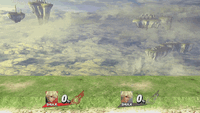
|
|---|
Taunts
- Up taunt: Shrugs, shakes his head, and waves a hand as if lecturing someone while saying "Now it's Shulk time!" (穏やかじゃないですね?, Not being gentle, huh?). The animation itself resembles the one Shulk performs when engaging in a conversation in Xenoblade Chronicles. The English phrase is a reference to Reyn, his best friend and one his party members, who occasionally utters the phrase "Now it's Reyn time!" whenever his Talent Art gauge is completely filled during combat. The Japanese phrase similarly references a popular phrase in Japan; in this case, a line Shulk commonly says when accepting quests.
- Side taunt: Grips the Monado's handle with his right hand while triumphantly pumping his left fist and announcing "I'm really feeling it!" (だんだん乗ってきたよ!, Gradually getting the hang of it!). References one of Shulk's voice clips in Xenoblade Chronicles when his tension level increases in combat.
- Down taunt: Grips the Monado with both hands, activates it and poses similarly to when he activates Buster while saying "This is the Monado's power!" (モナドの力よ!, The Monado's power! / The power of the Monado!). If timed correctly, it can dodge certain projectiles such as Fox's and Falco's Blasters, Link's Hero's Bow, and Pit's Palutena Bow. References one of Shulk's lines when he activates the Monado's Talent Art in Xenoblade Chronicles.
| Up taunt | Side taunt | Down taunt |
|---|---|---|
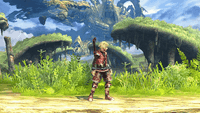
|
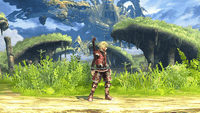
|
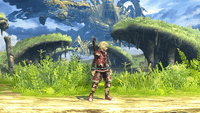
|
Idle poses
- Taps his foot while making a thinking gesture. Based on his idle animation from Xenoblade Chronicles.
- Tenses and quickly looks behind himself, then in front of him before easing up.
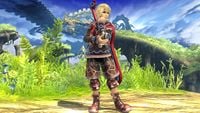 |
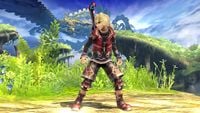
|
|---|
Crowd cheer
| English | Japanese | |
|---|---|---|
| Cheer | ||
| Description | Shulk! Shulk! Shulk! | Shuruku! |
| Pitch | Group chant | Female |
Victory poses
- Swings the Monado a few times while it is active, then holds it level to his head as he deactivates its beam blade, saying either "The future is ours to decide." or "I've got a good rhythm going!" In Japanese respectively, they are みんなの気持ちが伝わってきたよ! (Everyone's feelings have been coming through!) or ほんと、いい流れがつくれているよ! (For real, this makes it a good flow!)
- Swings the Monado upward, places it on his back, and poses with his left hand on his hip, saying either "I got through that pretty good!" or "This is a good result!" In Japanese respectively, they are よかった、これで解決ですね. (All good, it's been quite resolved.) or 結構よい仕上がりだね? (It was a splendid completion, huh?)
- The former English quote Shulk has a chance of exclaiming after finishing a battle in Xenoblade Chronicles, although it has also been changed from plural in that game to singular in SSB4, even in Team Battles, where it is his only line.
- Bows down with the Monado held lengthwise, activates its beam blade and then either
 quickly flexes his fingers before re-grabbing the Monado's handle or
quickly flexes his fingers before re-grabbing the Monado's handle or  continues to hold its handle before posing with the Monado backhandedly, saying either "I can change the future!" or "I can feel the power!" In Japanese respectively, they are 未来は.....変えられるんだ! (The future.....I can change it!) or うん、力を感じる. (Hmm, I feel the power.)
continues to hold its handle before posing with the Monado backhandedly, saying either "I can change the future!" or "I can feel the power!" In Japanese respectively, they are 未来は.....変えられるんだ! (The future.....I can change it!) or うん、力を感じる. (Hmm, I feel the power.)
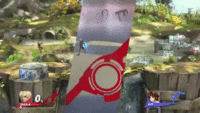 |
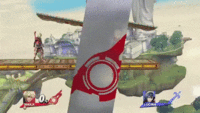 |
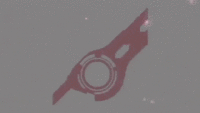
|
|---|
In competitive play
Official Custom Moveset Project
| Character | Custom sets available | ||||
|---|---|---|---|---|---|
| 1113 | 2113 | 3113 | 1123 | 3123 | |
| 3213 | 1122 | 3122 | 1213 | 2123 | |
Notable players
Active
Inactive
Tier Placement and History
Opinions on Shulk’s overall viability in the metagame have greatly fluctuated since the game’s release. Upon release, Shulk was quickly discovered to be very flawed due to his moveset being very sluggish, having poor damage output, and the fact that some of his moves, such as forward smash, failed to work properly amongst other issues. As a result, Shulk was quickly considered to be one of the worst characters in the game. However, with the release of update 1.0.4, Shulk was significantly buffed, with his buffs mainly addressing many of the issues players had with him. Due to his unique Monado Arts gimmick and the discovery of new, character specific tech such as MALLC, Shulk’s position on the tier list became a hot topic of debate among players due to his perceived potential. Despite still having his main flaw of poor frame data, many considered him worthy of being considered a high tier character on the grounds that, if someone could master him, he would be a serious competitive threat.
However, as time went on, players’ opinions of Shulk drastically dropped. Despite the perceived power of his Monado Arts, Shulk failed to place high at major tournaments. In addition to this, as the metagame became more developed, Shulk’s weaknesses, mostly his poor frame data, were realized to be much more detrimental to the character than originally thought. As a result, Shulk gradually made his way back into the lower tiers in the minds of most players and was left with a small, albeit dedicated, playerbase. Despite receiving some buffs in future updates, most notably update 1.1.3, they didn’t address his poor frame data and failed to be enough to compensate. Because of this, Shulk was ranked 40th in the G tier on the first tier list, solidifying him as a low tier character. He took a slight drop on the second tier list and is currently ranked at 44th in the G tier on the grounds that, despite the potential of his Monado Arts and character exclusive tech, his flaws, most notably his poor frame data, are too significant for his potential to really shine. Despite this, some people believe Shulk to be underrated in the current metagame and cite his recent rise in tournament placements, such as DarkWolf managing to achieve 13th place at Get On My Level 2016, as evidence of this.
Trophies
- Shulk
In Xenoblade Chronicles, this young lad's colony is attacked by the Mechon, so he and his friends set off to take them down. In Smash Bros., his Monado Arts let him change his specialization during battle. You can choose to boost a stat—his jump or attack, for example—but other stats might drop as a result, so choose wisely.
In Xenoblade Chronicles, this young lad's colony is attacked by the Mechon, so he and his friends set off to take them down. In this game, his Monado Arts let him change his specialisation during battle. You can choose to boost a stat—his jump or attack, for example—but other stats might drop as a result, so choose wisely.
- Shulk (Alt.)
Shulk's up special Air Slash is an upward slash done during a jump. Press the button again quickly to launch opponents sideways. His side special Back Slash, on the other hand, is a downward swing with a very wide range, though using it leaves Shulk wide open. Try hitting foes from behind with this!
Shulk's up special, Air Slash, is an upward slash done during a jump. Press the button again quickly to launch opponents sideways. His side special, Back Slash, on the other hand, is a downward swing with a very wide range, although using it leaves Shulk wide open. Try hitting foes from behind with this to do more damage!
- Chain Attack
- In Xenoblade Chronicles, building up the party's team spirit would let them unleash a chain attack, using multiple Arts in a row to deal massive damage. In this game, Shulk's Final Smash calls party members Dunban and Riki to help obliterate an unlucky target... or multiple targets if you catch more than one in the circle of light!
- ShulkAllStarTrophy3DS.png
Alt. (3DS)
In Event Matches
Solo Events
- Mechanical Menace: Shulk must defeat a metal R.O.B., a metal Mega Man and Metal Face in a Stamina Battle.
- New Challengers 2: Shulk is one of the opponents fought in this event, alongside Greninja, Palutena, Robin, Dark Pit, Mega Man and Pac-Man.
- The Ultimate Swordsman: As Ike, the player must defeat Shulk, Link, Marth, Meta Knight, Toon Link, male Robin and female Robin. All of the opponents wield swords.
Co-op Events
- The Ultimate Battle: Two players select a character and must defeat the entire roster.
Alternate costumes

| |||||||

|

|

|

|

|

|

|

|
Gallery
Shulk's amiibo.
- Shulk Alt.png
Shulk's armorless alternate costume.
Using his forward smash on Sheik.
Using his up smash on Captain Falcon while activating Smash.
Using Back Slash on Donkey Kong and Link.
Using his down taunt alongside two Villagers using their down taunts.
Using Chain Attack, his Final Smash, which features Dunban and Riki.
With Luigi on Boxing Ring.
Shulk and Riki in Super Smash Bros. for Nintendo 3DS.
On Smash Ball standby on Final Destination.
Reveal trailer
<youtube>GUl1EkUJ46k</youtube>
Trivia
- Shulk makes a few references to his home game:
- The second hit of his neutral attack, the roundhouse kick, resembles Dive Sobat, one of Reyn's Physical Arts.
- His forward tilt resembles one of his basic auto attacks.
- His forward smash highly resembles Slit Edge, one of his Physical Arts.
- His down smash resembles War Swing, one of Reyn's Physical Arts.
- The standard attack Shulk performs when Vision activates resembles Stream Edge, one of his Physical Arts, while the alternate attack looks similar to Thunder, one of Dunban's Ether Arts.
- He retains his jumping animation from Xenoblade Chronicles, while his running animation and one of his idle poses are almost identical to how they appeared in said game as well.
- When it is not in use, the Monado simply hangs from his back. This carryover makes Shulk the only sword-wielding character in the Super Smash Bros. series that does not hold their sword when not attacking with it. Ganondorf and his Sword of Sages are exempt, due to the Sword of Sages' usage as a weapon only occurring as a custom move.
- Many of his voice clips are re-recorded versions of the lines that he would speak throughout Xenoblade Chronicles.
- His alternate Blast KO line, "Not good!" (不味いね!), is a reference to one of his battle lines from Xenoblade Chronicles, "Not good... I'm losing it...", which he mutters when his tension is at its lowest level in battle. This also makes Shulk one of the few characters to speak after being KO'd.
- Shulk is the only character to tumble towards the screen when footstooled, whereas other characters would spin towards the direction they were facing. He is also the only character to hit the screen with his back during a Screen KO. These animations make the Monado and its active Art more visible to the player.
- Shulk is the only human sword-wielding character that uses a "wobbling" sound effect while charging up smash attacks instead of the "unsheathing" sound that the rest of the sword-wielding characters use.
- Shulk is the only character (apart from Palutena and her up aerial) who can interrupt all aerials during their ending frames, which allows him to act out of them before he lands, such as replacing a back aerial's 19 frames of landing lag by performing a neutral aerial before landing, cutting its landing lag to 10 frames.
- The voice clip for his third victory pose, "I can change the future!", is missing from the Sound Test.
- Shulk, Wii Fit Trainer, and Bayonetta are the only playable characters in the Super Smash Bros. series with British voice actors.
- If playing on any 2D stages on Super Smash Bros. for Nintendo 3DS, such as Flat Zone 2 or Super Mario Maker, the Monado's beam blade will not align properly with the Monado itself during his first victory pose. Additionally, the beam blade will appear much smaller than usual during Shulk's third victory pose.
- Despite not being a third-party character, Shulk is placed alongside them in most official material, including the Super Smash Bros. for Nintendo 3DS roster and foldout. In the Super Smash Bros. for Wii U roster, Shulk is placed before the clones, and in the Super Smash Bros. for Wii U manual, he is placed before Bowser Jr. As a result of this placement, Shulk may be mistaken as a third-party character. However, since Nintendo acquired Monolith Soft in 2007 prior to the development of Xenoblade Chronicles, Shulk is not a third-party character.
| Fighters in Super Smash Bros. 4 | |
|---|---|
| Veterans | Bowser · Captain Falcon · Charizard · Diddy Kong · Donkey Kong · Dr. Mario · Falco · Fox · Ganondorf · Ike · Jigglypuff · King Dedede · Kirby · Link · Lucario · Lucas · Luigi · Mario · Marth · Meta Knight · Mewtwo · Mr. Game & Watch · Ness · Olimar · Peach · Pikachu · Pit · R.O.B. · Roy · Samus · Sheik · Sonic · Toon Link · Wario · Yoshi · Zelda · Zero Suit Samus |
| Newcomers | Bayonetta · Bowser Jr. · Cloud · Corrin · Dark Pit · Duck Hunt · Greninja · Little Mac · Lucina · Mega Man · Mii Fighter (Mii Brawler · Mii Gunner · Mii Swordfighter) · Pac-Man · Palutena · Robin · Rosalina & Luma · Ryu · Shulk · Villager · Wii Fit Trainer |
|
| |
|---|---|
| Fighters | Shulk (SSB4 · SSBU) · Pyra (SSBU) · Mythra (SSBU) |
| Assist Trophy | Riki |
| Stages | Gaur Plain · Cloud Sea of Alrest |
| Other characters | Azurda · Dunban · Fiora · Metal Face · Nia · Rex |
| Trophies and Spirits | Trophies · Spirits |
| Music | SSB4 · Ultimate |
